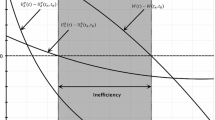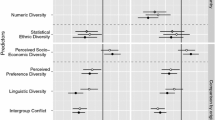Abstract
This paper advances the hypothesis that in societies that suffer from ethnolinguistic center-periphery tension it is harder to agree on public goods than on transfers. After micro-founding a new peripheral diversity index, it puts forth a simple theory in which the cost of public goods increases with peripheral ethnolinguistic diversity and tax compliance decreases with overall ethnolinguistic diversity. It then empirically explores the relation between public goods provision, transfers, peripheral diversity and overall diversity. Consistent with the theory, we find that higher levels of peripheral diversity are associated with less provision of public goods, but more transfers, whereas higher levels of overall diversity have a negative association with transfers. Public goods and transfers are therefore substitutes in their reaction to a change in peripheral diversity.
Similar content being viewed by others
Notes
We thus ignore the possible overlap between multiple dimensions of identity.
There are of course cases where the dominant group does not correspond to the biggest group. Examples include the Tutsis during different periods of Rwandan history and the Afrikaners of South Africa before the end of Apartheid.
This is similar to the resemblance function of Greenberg (1956).
Assuming convexity, instead of concavity, would give us an index of polarization. We later return to this issue.
Notice that Condition 3 requires concavity of the function \(f_{cp}(s_{0},\cdot ,\tau )\). Thus, this concavity, together with the other conditions, is sufficient to obtain that the solution to the maximization problem stated in the proposition is given by \(s_{k}^{*}\ge s_{l}^{*}\). However, concavity of \(f_{cp}(s_{0},\cdot ,\tau )\) is not a necessary condition to obtain the solution. For example, if the function \(f_{pc}(\cdot ,s_{k},\tau )\) is “sufficiently” concave, the function \(f_{cp}(s_{0},\cdot ,\tau )\) need not be concave.
As we will later argue, the price of the public good needs to be high enough. Since \({ PD}\) can be zero, this requires \(\eta >0\).
Greenberg’s B-index can be derived from the same identification-alienation framework. See Desmet et al. (2009).
Our results can be also extended to the case of a corner solution in which the tax rate is \(t=1.\)
Since we assume that transfers are positive, the price of the public good \( { PD}+\eta \) has to be high enough to ensure \(r>0\).
In many countries, especially in Africa and Asia, language coincides with ethnicity.
The dfbeta measures for each variable how influential each observation is. Following Belsley et al. (1980), we drop observations with an absolute value of dfbeta on either Greenberg’s B-index or peripheral diversity greater than \(2/\sqrt{(\# \text {obs})}\).
References
Alesina A, Reich B (2015) Nation-building. Harvard University, Cambridge
Alesina A, Devleeschauwer A, Easterly W, Kurlat S, Wacziarg R (2003) Fractionalization. J Econ Growth 8:155–194
Ashraf Q, Galor O (2013) The ‘Out of Africa’ Hypothesis, Human Genetic Diversity, and Comparative Economic Development. Am Econ Rev 103:1–46
Belsley DA, Kuh E, Welsch RE (1980) Regression diagnostics. Wiley, New York
Desmet K, Ortuño-Ortín I, Weber S (2005) Peripheral diversity and redistribution. CEPR Discussion Paper 5112
Desmet K, Ortuño-Ortín I, Weber S (2009) Linguistic diversity and redistribution. J Eur Econ Assoc 7:1291–1318
Desmet K, Ortuño-Ortín I, Wacziarg R (2012) The political economy of linguistic cleavages. J Dev Econ 97:322–338
Esteban J-M, Ray D (1994) On the measurement of polarization. Econometrica 62:819–851
Fearon JD (2003) Ethnic and cultural diversity by country. J Econ Growth 8:195–222
Gordon RG Jr (2005) Ethnologue: languages of the world, 15th edn. SIL International, Dallas
Gray RD, Atkinson QD (2003) Language-tree divergence times support the anatolian theory of Indo-European origin. Nature 426:435–439
Greenberg JH (1956) The measurement of linguistic diversity. Language 32:109–115
Gwartney J, Lawson R, Hall J (2012) Economic freedom of the world: 2012 annual report. Fraser Institute, Vancouver
La Porta R, Lopez de Silanes F, Shleifer A, Vishny R (1999) The quality of government. J Law Econ Organ 15:222–279
La Porta R, Lopez de Silanes F, Shleifer A (2008) The economic consequences of legal origins. J Econ Lit 46:285–332
Reynal-Querol M (2002) Ethnicity, political systems, and civil wars. J Confl Resolut 46:29–54
Shannon CE (1949) The mathematical theory of communication. University of Illinois Press, Urbana
Weber E (1979) Peasants into Frenchmen: modernization of rural France, 1870–1914. Chatto and Windus, London
Author information
Authors and Affiliations
Corresponding author
Additional information
We thank two anonymous referees for thoughtful comments. I. Ortuño-Ortín acknowledges the financial support of the Spanish Ministry of Science and Innovation, Project ECO-2013-42710-P, and S. Weber wishes to acknowledge the support of the Ministry of Education and Science of the Russian Federation, Grant No. 14.U04.31.0002, administered through the NES CSDSI.
Appendices
Appendix A: Proof of Proposition 1
To simplify the notation we drop 0 from the subscripts and write \(\tau _{j}\) instead of \(\tau _{0j}\).
(1) First consider the case \(\tau _{k}=\tau _{l}=\tau \). We have to show that \(s_{k}^{*}\ge s_{l}^{*}.\) Suppose, to the contrary, that \( s_{k}^{*}<s_{l}^{*}.\) Let \(s^{\prime }\in {\mathcal {S}}_{kl}({\overline{s}})\) be such that \(s_{j}^{\prime }=s_{j}^{*}\) for all j \(\ne k\), j \( \ne l\) and \(s_{k}^{\prime }=s_{l}^{\prime }=x\equiv \) \(\frac{s_{k}^{*}+s_{l}^{*}}{2}\). Since \({ PA}(s^{\prime },T)<{ PA}(s^{*},T)\), it follows that
By Condition 3, functions \(f_{pc}(s_{0},.,\tau )\) and \(f_{cp}(s_{0},.,\tau )\) are concave, which implies
and
It is straightforward to verify that inequalities (14)–(16) can not hold simultaneously. Thus, we have that \( s_{k}^{*}\ge s_{l}^{*}.\) Notice that \(\tau _{l}=\tau _{k}\) implies \( s_{l}^{*}\ge s_{k}^{*}\) and \(s_{k}^{*}\ge s_{l}^{*}\) so that \(s_{k}^{*}=s_{l}^{*}.\)
(2) Now consider the case \(\tau _{k}>\tau _{l}.\) We shall show that \( s_{k}^{*}\ge s_{l}^{*}.\) Suppose, in negation, that \(s_{k}^{*}<s_{l}^{*}.\) Let \(T^{\prime }\in {\mathcal {T}}\), be such that \(\tau _{j}^{\prime }=\tau _{j}\) for all \(j\ne l\) and \(\tau _{l}^{\prime }=\tau _{k}.\) Notice that \(\tau _{j}^{\prime }>\tau _{l}\). Similarly to the previous examination, let \(s^{\prime }\in {\mathcal {S}}_{kl}({\overline{s}})\) be such that \(s_{j}^{\prime }=s_{j}^{*}\) for all j \(\ne k\), j \(\ne l\) and \(s_{k}^{\prime }=s_{l}^{\prime }=\) \(x\equiv \frac{s_{k}^{*}+s_{l}^{*}}{2}.\) We have
This implies that
which is equivalent to
The argument used in case 1 above yields
which implies that
By rearranging the terms we obtain
Inequalities (19) and (21) imply
Since \(s_{l}^{*}>x\) and \(\tau _{k}>\tau _{l}\), Condition 4 implies that
and (23) and (21) do not hold simultaneously. Hence we conclude that \(s_{k}^{*}\ge s_{l}^{*}\).
Appendix B: Data sources and diversity indices
Absolute latitude The absolute value of the latitude of a country’s approximate geodesic centroid, as reported by the CIA World Factbook. Source: Ashraf and Galor (2013).
Child mortality Log of child mortality rate per 1000 live births, 1990–2010 average. Source: World Development Indicators, World Bank.
GDP per capita GDP per capita, constant 2005 US$, 1990–2010 average. Source: World Development Indicators, World Bank.
Illiteracy Percentage of people aged 15 and above who are illiterate, 1990–2010 average. Source: World Development Indicators, World Bank.
Improved sanitation Percentage of population with access to improved sanitation facilities, 1990–2010 average. Source: World Development Indicators, World Bank.
Legal origin Socialist, French, German or British legal origin Source: La Porta et al. (2008).
Language data Languages spoken in each country and language trees. Source: Ethnologue: Languages of the World, 15th Edition, SIL International, 2005.
Major religions Share of protestants, catholics and muslims in the population. Source: La Porta et al. (1999).
Measles immunization Percentage of children between the age of 12 and 23 months that have been immunized against measles, 1990–2010 average. Source: World Development Indicators, World Bank.
Population. Total population, 1990–2010 average. Source: World Development Indicators, World Bank.
Population above 65 Population ages 65 and above, % of total, 1990–2010 average. Source: World Development Indicators, World Bank.
School attainment. Log of 1 \(+\) average years of schooling of population aged 25 or above, 1990–2010 average. Source: Barro R. and J.W. Lee v. 1.3, 04/13.
Road density Road network density, km per 1000 inhabitants, 2001–2010 average. Source: World Development Indicators, World Bank.
Terrain roughness The degree of terrain roughness of a country, calculated using geospatial surface undulation data reported by the G-ECON project (Nordhaus 2006) at a 1-degree resolution. Source: Ashraf and Galor (2013).
Transfers Transfers and subsidies as percent of GDP: Average for 1990, 1995, 2000, 2005 and 2010. Source:Gwartney et al. (2012), Economic Freedom Dataset, Fraser Institute.
Rights and permissions
About this article
Cite this article
Desmet, K., Ortuño-Ortín, I. & Weber, S. Peripheral diversity: transfers versus public goods. Soc Choice Welf 49, 787–823 (2017). https://doi.org/10.1007/s00355-016-1017-5
Received:
Accepted:
Published:
Issue Date:
DOI: https://doi.org/10.1007/s00355-016-1017-5




